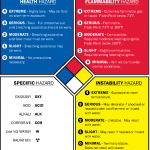| NFPA (National Fire Protection Association) codes and standards - Standards and guidelines for design of various fire protection systems and fire protection equipments such as fire hydrants, fire fighting pumps etc. |
|
| Fire Fighting : use of carbon dioxide for protective measures - Carbon dioxide is a colorless, odorless, electrically nonconductive gas which is a suitable medium for putting out fires. It is approximately 1.5 times heavier than air and forms dry ice when discharged into the atmosphere. It extinguishes fire mainly by reducing the concentration of oxygen, as can be seen from the fire triangle. Being heavier than air combined with its ability to displace oxygen makes it a really dangerous fire extinguishing medium to be used by humans. | |
| Fire Fighting : use of CO2 - calculation of required quantities - Article presents guidelines for estimating quantities of carbon dioxide requirement for fire fighting systems as per related codes and standards. |
|
| Fire Sprinklers and Fire Sprinkler System types - A fire sprinkler system consists of a piping network with fire sprinklers extending all over the fire-protected area. There are various types of sprinklers. However, generally speaking, there are two (2) major types of sprinklers: the open type and the closed type fire sprinklers. Furthermore, following types of fire sprinkler systems are discusses in the article. (I) Deluge sprinkler system (ii) Dry pipe sprinkler system (iii) Wet pipe sprinkler system (iv) Pre-action sprinkler system |
|
| Fire Fighting Basics : Upper and Lowe Explosive Limits for gases - A combustible mixture can only be produced within a limited band of gas/air concentration. This band is unique for each gas and vapor and is characterised by an upper level, characterised as the Upper Explosive Level (UEL) and a lower level, known as Lower Explosive Level (LEL). These values are also sometimes referred to as the lower and upper flammability limits (LFL and UFL respectively). |
 |
 |
Fire Fighting Basics : Fire Triangle and Fire Tetrahedron - Combination of fuel, heat and oxygen leads to fire and is therefore considered as Fire Triangle. Consequently, when trying to put out a fire, we strive to remove at least one of these three components. Further research over the years revealed a fourth necessary component of fire, the chemical chain reaction. The Fire Triangle was consequently transformed to the Fire Tetrahedron. |
| Flash Point - Flash point is a property characterizing flammable gases and liquids. By definition, the flash point of a flammable fluid is the lowest temperature at which the fluid can form an ignitable mixture with the air. Flash point of fluids and fluid mixture is used for evaluating potential hazard which can be caused by leakage of that fluid. This is the basis for hazardous area classification. | |
| Types of spray Systems for fire protection - 1. Water spray type fixed system 2. Foam water spray systems 3. Fire protection systems with aerosols 4. Fire protection systems using clean agents 5. Water mist spray systems for fire fighting |
|
 |
How Gas Detectors work? : catalytic type detectors - Catalytic detectors are the ones with the most widespread use nowadays. Their main advantages over other methods of combustible gas detection are simplicity, accuracy and relatively low-cost. Their operation is quite straight-forward: they work on the principle that a combustible gas can be exothermically oxidized. One sensor of this type typically consists of two identical beads, one active and the second, the reference bead. |
| How Gas Detectors work? : infrared type detectors - Infrared gas detectors work based on the principle of infrared absorption. Their mode of operation can be briefly described as follows: an infrared source illuminates a volume of gas that has entered inside the measurement chamber. The gas absorbs some of the infrared wavelengths as the light passes through it, while others pass through it completely unattenuated. |  |
| How Smoke Detectors work? : Ionisation type detectors - A typical ionization smoke detector typically consists of two plates in close proximity to each other and a radioactive source. The radioactive source constantly releases alpha particles knocking off electrons from surrounding air atoms, ionizing the nitrogen and oxygen atoms. The ions are attracted to the charged plates, thus creating a small, continuous electric current. | |
| How Smoke Detectors work? : Photoelectric type detectors -Photoelectric smoke detector operation is typically based either on the light scattering principle (light can be scattered due to the smoke particles reflection) or the light obscuration principle (reduction of light passing through smoke particles). | |
 |
NFPA's Fire Diamond - Fire diamond is defined in NFPA 704. Proper labelling having the form of a diamond is used in our days in order to quickly identify the risks posed by hazardous substances. |